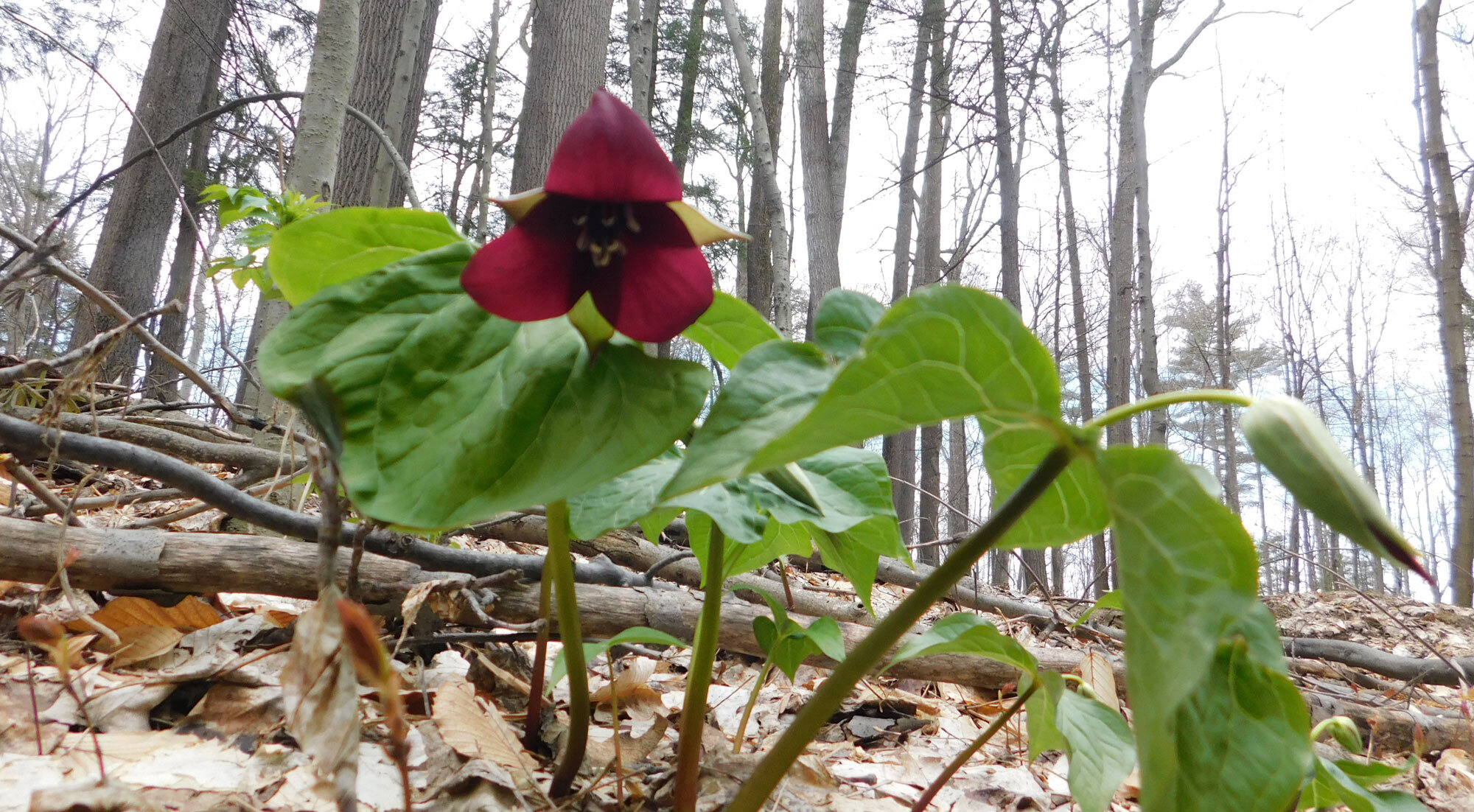The Thrill of the Trillium
Trilliums in Smith Woods. Photograph by Marvin Pritts.
by Marvin Pritts
Last updated May 6, 2020
Every year at the end of April, I would frequently hike up the hill behind my childhood home to a wooded glen, eagerly anticipating the bloom of the white trillium that graced the steep hillside of that Pennsylvania mountain. That day of first bloom was almost as anticipated as Christmas because I knew that this marked the first days of true spring and that the countdown to the end of school had begun. There was no turning back nature’s clock now. I ran down the mountain. “Mom” I yelled, “the trilliums are in bloom!” Within a few days the entire family would walk up the mountain to view the spectacle.
One early spring, twenty years later, I moved south of the village of Trumansburg. One day while driving into town, I saw the forest floor across from the fairgrounds covered with those same white trilliums. What a sight!
Red (left) and white (right) trilliums. Photograph by Marvin Pritts.
All plants have scientific names and some of these names relate to the characteristics of the plant. The trillium (prefix – “tri”) is named for the three petals, sepals and leaves that the plant exhibits. Flowering plants known as monocots typically have flower parts in multiples of three. In contrast, dicots, the other group of flowering plants, have flower parts in multiples of four or five. For many years Trillium was considered a member of the Lily Family, but then taxonomists moved them to a different family that is closely related. There are 39 species in North America, with five found in New York State. The most common are the white (T. grandiflorum) and red (T. erectum).
Flower of the white trillium. Photograph by Marvin Pritts.
Trillium inhabit older undisturbed forests with lots of leaf litter. Since the tree canopy closes quickly and the forest floor becomes shaded by early June, low-growing wildflowers must flower and fruit before light levels plummet. Hence, early May is the best time to see these spring ephemerals in their glory—hepatica, bloodroot, wild ginger, spring beauty, and trout lily. But the most spectacular of these spring wildflowers is the trillium.
Old growth forests have been around for many thousands of years, and nature has facilitated the evolution of several complex relationships between these wildflowers and other forest inhabitants. One of the most fascinating is the pollination system of the red trillium. These purple-red flowers emit a nasty smell, much like rotting meat. Instead of attracting bees to pollinate them, they attract flies and beetles. No need to provide nectar to flies, rather they offer up some pollen which, if luck would have it, transports the pollen to another flower, maintaining the genetic diversity of the species. Amazingly, flowers all over the world have evolved purple flowers with putrid smells that attract flies and beetles; skunk cabbage is a well-known example. Pawpaw, a native North American tree, has such flowers but is not even closely related to trillium. The most famous flower of this type is the corpse lily, native to the jungles of Sumatra, 10,000 miles from New York’s red trilliums, or Stinking Benjamins as they are sometimes called.
A red trillium in Smith Woods. Photograph by Marvin Pritts.
Trillium seeds with attached pouches of fatty acids. Photograph by The Nature Niche.
A second amazing adaptation comes in the form of a trillium seed with a pouch of fatty acids attached to it. Why would the trillium do such a strange thing? Scientists learned that ants will transport the seed back to their nests, eat the oily treat, then discard the seed into the garbage pit laden with decomposing bodies of dead ants and other nutrient-rich items, perfect for seed germination and establishment. This trick is not only used by trilliums, but by sedges, bloodroot, spring beauties, violets and Dutchman’s breeches. Trillium are herbaceous perennials (the tops die back but the roots live for many years). It can take up to seven years for a trillium seedling to become large enough to produce a flower. That’s why you only see Trillium in woods that have not been disturbed for many years.
Over the last thirty years, the trillium display diminished in Smith Woods. With the increasing deer population, grazing of vegetation on the forest floor became more pronounced so that tree seedlings were not establishing and wild flowers were being eaten before they matured and flowered. The Paleontological Research Institution, which manages Smith Woods, erected a fence two years ago to exclude deer. Last year the trilliums appeared to be making a comeback, but this year, they are spectacular! The red trillium is the predominant early wild flower this spring, and will be followed by the white grandiflorum. I’ve been visiting Smith Woods a few times every week this spring to see the display unfold.
My parents still live in southwestern Pennsylvania and are over 90, so I won’t be able to show them the remarkable display of trillium in Smith Woods in person. But I will be able to take photographs for them. I encourage readers to do the same before the tree canopy closes and another year passes before the glorious trilliums emerge from the cold ground once again.
A trillium in Smith Woods covered by a late April snow. Photograph by Marvin Pritts.







